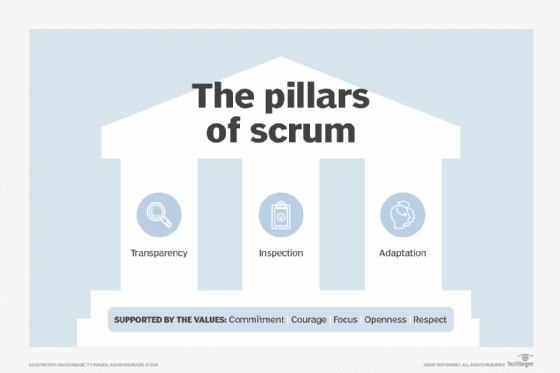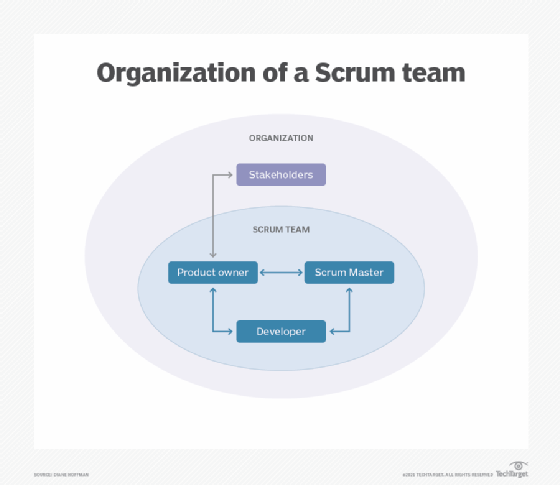
Getty Images/iStockphoto
10 essential Scrum Master skills
From sprint planning to servant leadership, Scrum Masters help Agile developers, product owners and other team members perform at their best. Here's what makes a good Scrum Master.
You don't have to be a full-stack developer to become a Scrum Master, but you should be creative and quick with a whiteboard marker.
A Scrum Master facilitates the procedures of Scrum, a framework for Agile development. This person orchestrates the events, also called ceremonies, such as the daily Scrum and the sprint review. Scrum Masters enable collaboration, resolve conflict and improve processes; they exist to serve the team.
When work interruptions occur, Scrum Masters should lead collaborative efforts to address impediments -- especially if they're external. For example, requirements changes and technical issues stall work during both individual sprints and the fuller development cycle. To address such problems, the Scrum Master needs to be proficient with the development tools a team uses. A Scrum Master with these advanced skills can help a software team greatly.
Beyond project management abilities, skilled Scrum Masters are also team leaders. They build trust, promote healthy conflict, get commitment, ensure accountability and maintain focus on sprint goals. To do so, they must understand the technical product developers are building.
If you're ready to advance your Agile development career, study up on these essential Scrum Master skills.
1. Learning to build Scrum knowledge
Study core Scrum pillars and values to become an effective Scrum Master. Three pillars of Scrum exist: adaptation, transparency and inspection. And the framework has five values: respect, courage, openness, commitment and focus.

Scrum competency requires knowledge of these concepts and activities:
- daily Scrum
- definition of done
- development team
- increment
- product backlog
- product owner
- Sprint
- sprint retrospective
- sprint review
- timeboxing
The book Essential Scrum by Kenneth S. Rubin is a great resource for Scrum Masters of any skill level. An Agile and Scrum trainer, Rubin describes the Scrum process and characteristics.
2. Execution of Scrum
Scrum Masters must demonstrate competency with the framework. A certification proves that you understand Scrum and can apply it in real-world scenarios.
Choose a certification path based on your knowledge level and job. Basic certification covers the fundamentals of the Scrum framework. An experienced Scrum Master may want to pursue advanced certification to test their abilities to apply skills to more complex projects and organizations.
| Compare the best certifications for Scrum Masters | ||||||
| NAME |
DIFFICULTY |
COST |
ACCREDITATIONS |
QUESTIONS |
DURATION |
PASS |
| PSM I |
Beginner |
$150 |
+460,000 |
80 |
60 mins |
85% |
| PSM II |
Intermediate |
$250 |
+18,000 |
30 |
90 mins |
85% |
| PSM III |
Expert |
$500 |
+1,000 |
30 |
150 mins |
85% |
| SPS |
Expert |
$250 |
+4,700 |
40 |
60 mins |
85% |
| Jira |
Intermediate |
$100 |
N/A |
75 |
180 mins |
63% |
| SAFe Agile |
Expert |
$3000 |
N/A |
45 |
90 mins |
77% |
| AWS |
Beginner |
$100 |
+400,000 |
60 |
90 mins |
70% |
Some certification organizations require applicants to take a course prior to the exam. The certification exams from the two dominant certifiers require passing grades to obtain the certification. CSM from the Scrum Alliance requires a 74% (37 out of 50 answers correct), while the PSM from Scrum.org requires 85% (68 of 80 answers correct). Both exams run for 1 hour. Some Scrum Master certifications expire.
Check whether your company supports training classes under its continuing education program. If you already hold a basic Scrum Master certification, consider an advanced certification.
3. Leadership
The Scrum Master is the glue between the product owner and the development team. The relationship between the Scrum Master and the product owner is key to success.
The product owner is responsible for user story creation. Then, the entire Scrum team reviews these stories to finalize, estimate and prioritize them. The Scrum Master ensures the development team fully supports story refinement, also called backlog grooming. The product owner takes on product challenges and changes in feature prioritization. To assist the product owner, the Scrum Master informs the development team of product changes. Scrum Masters should especially highlight changes that affect work in progress during a sprint.
The Scrum Master helps the product owner by being a good leader. A Scrum Master:
- holds the Scrum team accountable to the defined sprint goals;
- implements effective product backlog management;
- helps the Scrum team understand story grooming and estimated product backlog items;
- arranges the product backlog to maximize value; and
- facilitates Scrum events.
Conflicts will arise in performing this service. A good leader is organized and communicates well. Scrum Masters must be accountable and build consensus throughout an organization. Work with the team every day to help members achieve sprint goals.
Learn new skills from books about leadership. Many titles focus on leading Agile teams, but they don't have to pertain to Agile or Scrum specifically. I recommend The Five Dysfunctions of a Team by Patrick Lencioni. Find a book that resonates with your personal approach to leadership.
Sharpen your leadership skills through practice. Take on a nontechnical leadership role outside of your job. Look into community volunteer opportunities, such as coaching a youth sports team. The same elements of collaboration and teamwork that win soccer games can apply to successful Agile software delivery.
4. Collaboration
Scrum Masters' responsibilities extend beyond their own development teams. To remove impediments for their teams, Scrum Masters collaborate with stakeholders and other dev teams. Some Scrum experts say this interaction falls outside of the traditional Scrum Master role, but it's necessary work, and you're the right person to do it. As a Scrum Master, use leadership skills to collaborate across teams, negotiate schedules and facilitate technical meetings.

5. Organization
Scrum teams require structure and planning, so Scrum Masters must facilitate a process to keep everyone on track. While a Scrum Master should be an organized individual, the role requires more than just personal management skills.
The Scrum Master needs to have honed skills in team management. A team agreement is in the Scrum Master's toolbox to get everyone on the same page. The team agreement, or team operating procedure, is a document that defines things for the team, such as core working hours, Scrum ceremony formats, escalation paths and stakeholder involvement. The agreement is a living document; the team should modify it as the group changes. These guidelines should enable transparency across personalities and roles.
Organizational skills are also key to collaboration with the product owner on the product backlog. The Scrum master ensures team members complete their task assignments and that the overall feature is tracking to delivery. Scrum teams can use project management tools to keep the entire team connected and organized.
6. Project management tools expertise
Scrum Masters should develop advanced skills on project management task boards and collaboration and documentation software, including calendars.
Task boards are the primary tool Scrum teams use to manage, organize and track work. Teams should be able to look at the task board and know how the sprint and project overall are tracking. Tasks boards are common online list-making, issue-tracking and project-management tools; options include Asana, and Atlassian's Trello and Jira. The task board structure illustrates project workflows and the dependencies and hierarchical relationships between tasks. The Scrum Master should be able to set up the task board, establish workflows and move tasks, and help team members move tasks properly.
Development teams use collaboration software for documentation and group communication throughout the development cycle. Teams capture user stories, discuss work and resolve problems. Inefficient use of messaging tools can overburden a team, interrupting the work. The Scrum Master must set guidelines, choose channels and otherwise manage these team communication tools.
The Scrum Master also runs all Scrum events. Use a calendar tool, such as Microsoft Outlook or Google Calendar -- or a calendar within the collaboration platform -- to send and manage event invites.
Scrum master skills checklist
- Facilitates Scrum team agreement and activities: standups, backlog meetings, sprint planning, team review, retrospectives
- Knows Scrum values, principles and practices
- Adapts Scrum framework for team needs
- Coordinates with other teams and stakeholders
- Understands the technical product and processes
- Resolves issues and removes impediments
- Communicates and listens well
- Collaborates with groups and organizes team tasks
- Coaches colleagues to success
- Adapts to change
7. Agile and software development knowledge
At its core, Scrum helps software development teams build products adaptively. Technical knowledge on how to develop software in an Agile environment can help Scrum Masters move teams ahead with the proper tools and techniques.
Scrum Masters should be familiar with the technical product under development and with the development tool suite. A Scrum Master does not need to be able to write software. However, understanding the product's technical features and use cases is essential to effectively run the Scrum project.
Scrum Masters can even participate in end-to-end acceptance testing of the product.
8. Listening
Be a good leader, which starts with being a good listener; consider the servant leader model. Listening is a must-have Scrum Master skill. Pay close attention at daily standups, backlog meetings, sprint planning, team review and the retrospective. Hear where issues arise, raise awareness of them and lead the team to a resolution.
9. Adaptability with change
Many Scrum Masters fixate on following the framework. Instead, think of Scrum as a foundational tool rather than the goal. Agile development centers upon the concept of change, and the framework and processes necessary to manage change. So, the Scrum framework must adapt to best support the team. Every team executes Scrum ceremonies but works differently from others.
10. Risk management
The Scrum Master should be knowledgeable in common processes to manage risk. They can facilitate that process, from risk identification through mitigation and monitoring.
Some risks are related to process, skills or Technical debt. All projects accept some level of debt. However, during development, issues can arise that are impediments to tasks. These issues may result in risks that add to quality, feature or UX debt. The Scrum Master helps to identify dangers, and works with the development team to analyze, rank and communicate them. This skill helps the product owner and stakeholders make decisions to best mitigate or reduce the risk.
A Scrum Master who learns, leads and listens, and applies their knowledge of processes and associated tools where needed, is in the right position to make the team run efficiently. These Scrum Master skills support rapid, predictable delivery at every iteration. And that kind of software delivery is ultimately why the team chose Scrum.






